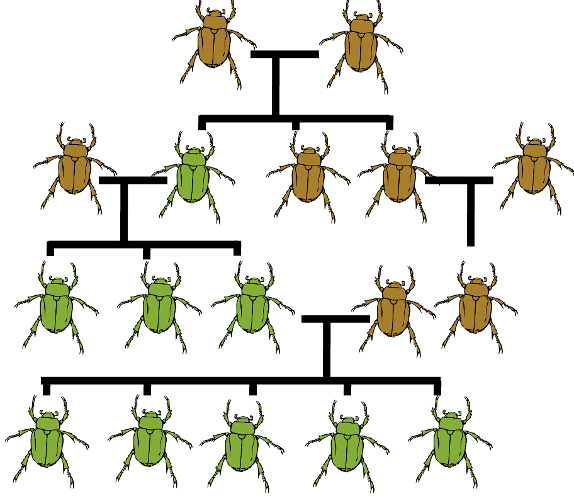BI111 Week 4-5
1/23
There's no tags or description
Looks like no tags are added yet.
Name | Mastery | Learn | Test | Matching | Spaced |
|---|
No study sessions yet.
24 Terms
Dawrins observations and inferences 1
observation : populations have a great capacity to grow, but are ultimately limited by resource availability
inference : compétition between individuals in a population for resources
Darwins observations and inferences 2
observation: individuals vary within populations in heritable traits related to competitive success (ultimately survival)
inference: some individuals more likely to survive and reproduce than others
Darwins observations and inferences 3
observation: individuals may also vary within populations in heritage traits related to reproductive competitive success
inference: some individuals more likely to reproduce than others
Adaptive Evolution (natural selection)
a populations characteristics change over time as advantageous traits become more common

change in allele frequencies over time
evolution encompasses all types of changes brought about by selection processes and chance events
Domesticated species and adaptation
depending on environnent, different phenotypes are adaptive or deleterious
traits (with genetic basis) that might otherwise put individuals at a competitive disadvantage may be desirable to humans and thus become favoured by selective breeding
Darwin’s pigeon
artificial selection is an analogous process (similarity of function and superficial resemblance of structures that have different origin) to natural selection
anagenesis
accumulation of changes in linages, with no change in number of species
cladogenesis
accumulation of changes in 2 or more descendant species
Rate of Speciation
refers to the speed that new species arise
Misconception
selection will produce perfectly adapted species
Maladaptation can arise from;
mutation
genetic drift/inbreeding
variation in selection, heterozygote advanatage
gene flow
Homologies
resemblance due to recent common ancestor
E.g bones that support wings of bats, birds and pterosaur all look like modifications of the pentadactyl limb
Homoplasties
resemblance due to similar selective pressures to fill niche
Analgous
Analogous structures in biology are like having different tools that do the same job but are made differently.
For example, a bird's wing and an insect's wing both help them fly, but they're built differently and didn't come from a common ancestor. They evolved separately to solve the same problem of flying.
Principle of monophyl
all groups in a clade include common ancestors and all its descendants
Monophyletic Taxon
include ancestor and descendant
Polyphletic Taxon
species from different evolutionary lineage (tricked by superficial similarities)
Paraphyletic taxon
include ancestor and some of its descendants
Rooted
tail gives directionality where it changes what order
Unrooted
not knowing where first split occurred, maybe know some connections
scaled
length is important
long arms mean more different
short means they’re the same
Unscaled
no difference